Classic Camera Corner
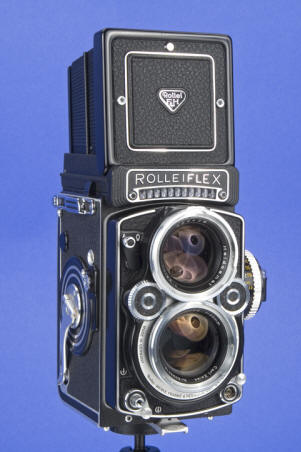 The Amazing Rolleiflex TLR The Amazing Rolleiflex TLR
by Graham Law, President, Seawood
Photo
January 2008
Every month we have hundreds of used cameras come
through Seawood. And even a self-proclaimed camera
junkie such as myself gets somewhat jaded looking
through the myriad of gear. But every now and then
someone opens a bag or a box and I have to catch my
breath because inside there’s a ROLLEIFLEX!
There’s something about
that marquis that makes it special. Maybe it’s the
history of usage by some of the world’s greatest
photographers such as Irving Penn, Richard Avedon,
Robert Doisneau, Imogen Cunningham, Helmut Newton and
such.
Or perhaps it’s just
that the cameras themselves are so damn cool! Post-war
Rolleiflex twin-lens reflex cameras are as good as
cameras get.
While Rollei wasn’t the
only manufacturer to build a quality TLR camera, (Mamiya,
Zeiss, Voightlander, etc) they certainly perfected it.
Medium format cameras
have an obvious advantage over 35mm cameras due to film
size (at least 3x larger).
There are problems, however, with having such a large
shutter curtain thwacking open and closed when the
camera is fired. This causes blurred photos due to
unwanted vibrations at low shutter speeds. Most cameras
don’t have an instant return mirror, so you have to
advance the camera and cock the shutter before you can
re-compose your subject, making sequential photos
difficult. Flash synch speeds are only 1/60th
or below in most cases.
TLR’s don’t share these
maladies. Leaf shutter lenses have virtually no
vibration. I routinely get razor sharp hand-held images
at 1/30th and below with my Rollei. Since you are
viewing through the top lens while the bottom lens is
doing all the work the viewfinder never goes dark, even
while the camera is being fired.
Flash synch works at
all speeds, making balanced fill-flash a breeze in sunny
conditions.
The biggest problem
with TLRs is parallax. Because you are viewing through a
lens that is centered an inch or so above the actual
taking lens, what you see is not what you get. Not such
a big deal when shooting to infinity, but a real problem
under 10’.
To address this Mamiya
used to sell a rather goofy device called a Paramender.
This attached to your tripod and allowed you to quickly
lift your camera at time of exposure so that the taking
lens is moved to where the viewing lens used to be.
Rolleiflex devised a
much more elegant way to deal with parallax. As you
focus on close objects the viewfinder window
automatically crops the image to accurately frame the
image. Brilliant!
Speaking of
viewfinders, the Rollei waist-level finder is work of
art. It snaps open and closed quickly. There is no need
to fold down three sides of the finder before you close
it; just pull the door shut. (I love viewing through a
waist-level finder. With a single lens reflex camera, as
soon as you place your eye against the viewfinder you
become a part of what you are viewing. Looking down on a
ground glass with a TLR, you can be much more objective
about composition. It’s like looking at transparencies
on a lightbox.).
Critical focus is
easily checked by flipping out the built in loupe.
Though the image you
see is right side up, it is backwards from left to
right, so panning on a moving object takes some getting
used to. For this reason some
models have a built in sports finder. This is quite
ingenious. First, you focus on the ground glass. Then,
with the finder open, you push in a panel on it’s front.
This folds inside, allowing you to peer straight through
a target window in the back of the finder. Viewing
through this lets you frame your subject.
As if this wasn’t cool
enough, there is a small window below that one that
allows you to see a reflected image of the ground glass
so you can check focus without taking your eye off the
back of the camera (upside down, and dim, but hey, it
works!) Later models such as
the 2.8E and F have interchangeable finders, including a
prism for eye-level viewing.
Rollei made lots of
interesting accessories for the later models, including:
- The
Rolleimeter: Do you prefer
rangefinder focus? Rollei made a gismo called a
Rolleimeter that affixes to the front of the open sports
finder. There is a focus-spot in the center of a clear
piece of glass that lets you align a double-image, just
like an M-Leica!
|
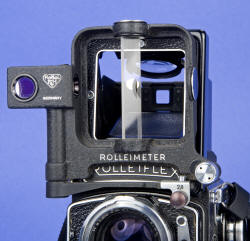 |
- The Rolleikin: This
is an adapter that allows you to use 35mm film in the Rollei. Why, you ask? Well, the
80mm lens is perfect for portraits in 35. And as you are
only using the ‘sweet spot’ of the lens, the results are
remarkable.
|
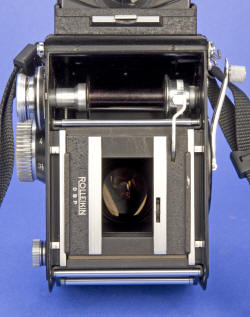 |
- Stereo Adapter: A
slide bar that lets you take stereo-pairs for 3d
photography.
|
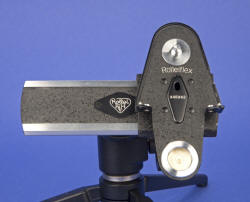 |
- Panoramic Mount:
Camera rotates to up to 10 click-detents with frames
barely overlapping.
|
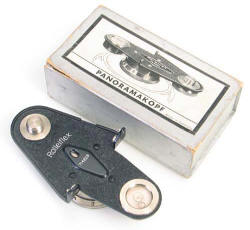 |
- Binocular Focusing
Hood: Focus on the ground glass with both eyes. Great
for use in bright surroundings. Get you lots of strange
looks, too.
|
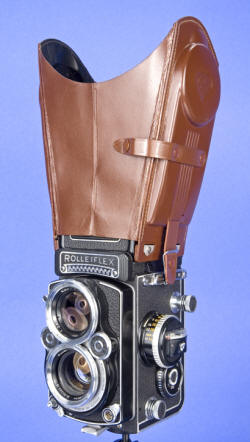 |
|
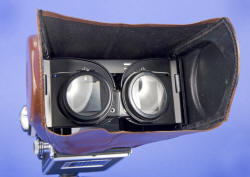 |
- Mutars:
Since you
can’t change lenses on a Rollei, you simply add them! A
wide angle and telephoto lens was available.
|
 |
| Rollei also had special
camera models with a permanently affixed wide angle or
telephoto lens. The wide angle has a
Zeiss 55mm Distagon f4.0 lens and a special sports
finder that shows the wider field of view.
|
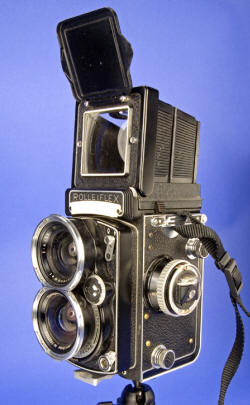 |
| This is one of my
favorite cameras. Razor sharp, light and build like a
tank. The Tele Rollei has a
135mm Zeiss Sonnar f4.0. lens. Great portrait lens, but
only focused down to two meters (which is why the next
photo shows the nifty swing-away close focus adapter!).
|
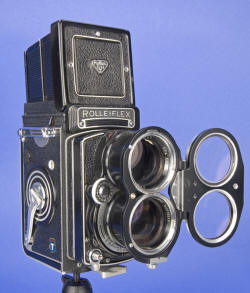 |
| Rollei TLR’s became a
bit more modernized with the advent of the GX models in
1987. Though basically the same camera, they added an
LED light meter to the viewfinder and SCA system TTL
flash capability.
|
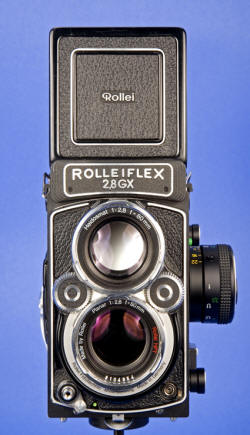 |
New Rolleiflex F series
cameras are still being produced today! They have even
re-introduced the Tele and Wide Angle cameras.
Considering the build
quality and fine optics, used Rolleiflex TLR’s are quite
a bargain at current market prices. Excellent condition
models with the slower 3.5 Zeiss Tessar or Schneider
Xenar lenses generally sell for well under $500.
Brighter 2.8 models are
available for under $800, and the very coveted 2.8F
model (uses 120 or 220 rollfilm) goes for around
$12-1500.
So, if you see anyone
with a bag or a box full of cameras and one of them
happens to be a Rolleiflex, don’t let it get away!
BACK TO CLASSIC CAMERA CORNER
INDEX > |



